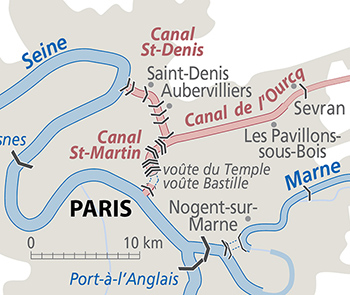Canal Saint Martin
| Canal Saint-Martin | |
|---|---|

Location of the three Paris canals (zooming on the Saint-Martin and Saint-Denis), from the Inland Waterways of France map by David Edwards-May, publ. Imray, 2012
|
|
| Specifications | |
| Length | 4.6 km |
| Maximum boat length | 40.70 m (133.5 ft) |
| Maximum boat beam | 7.70 m (25.3 ft) |
| Locks | 9 |
| History | |
| Current owner | Ville de Paris |
| Date approved | 1802 |
| Date completed | 1825 |
| Geography | |
| Start point | Paris Place de Stalingrad (Bassin de la Villette, Canal de l'Ourcq) |
| End point | Paris Quai de la Râpée (entrance lock from Seine) |
| Connects to | Seine, Canal de l'Ourcq |
The Canal Saint-Martin is a 4.5 km long canal in Paris, connecting the Canal de l'Ourcq to the river Seine. Over nearly half its length (2069 m), between the Rue du Faubourg du Temple and the Place de la Bastille, it was covered in the mid-19th century to create wide boulvards and public spaces on the surface. The canal is drained and cleaned every 10–15 years, and it is always a source of fascination for Parisians to discover curiosities and even some treasures among the hundreds of tonnes of discarded objects.
Construction of the canal was ordered by Napoleon I in 1802, in order to create an artificial waterway for supplying Paris with fresh water. The water diverted from the river Ourcq would support a growing population and help avoid diseases such as dysentery and cholera, also supplying fountains and allowing the streets to be cleaned.
Gaspard de Chabrol, prefect of Paris, proposed building a canal from the Ourcq River (starting 100 km northeast of Paris). The canal was dug from 1802 to 1825, funded by a new tax on wine. The canal was also used to supply Paris with food (grain), building materials, and other goods, carried on canal boats. Two ports were created in Paris on the canal to unload the boats: the Port de l'Arsenal and the Bassin de la Villette.
By the 1960s, traffic had dwindled to a trickle and the canal narrowly escaped being filled in and paved over for a highway.
The entrance to the canal from the vast terminal basin (Bassin de la Villette) of the Canal de l'Ourcq is at a double lock near the Place de Stalingrad. Continuing towards the river Seine, the canal is bordered by the Quai de Valmy on the right bank and the Quai de Jemmapes on the left, passing through three more double staircase locks before disappearing under the three successive voûtes or tunnels – du Temple, Richard-Lenoir and Bastille – to emerge in the Port de l'Arsenal, the principal port for boats visiting and residing in Paris.
...
Wikipedia
